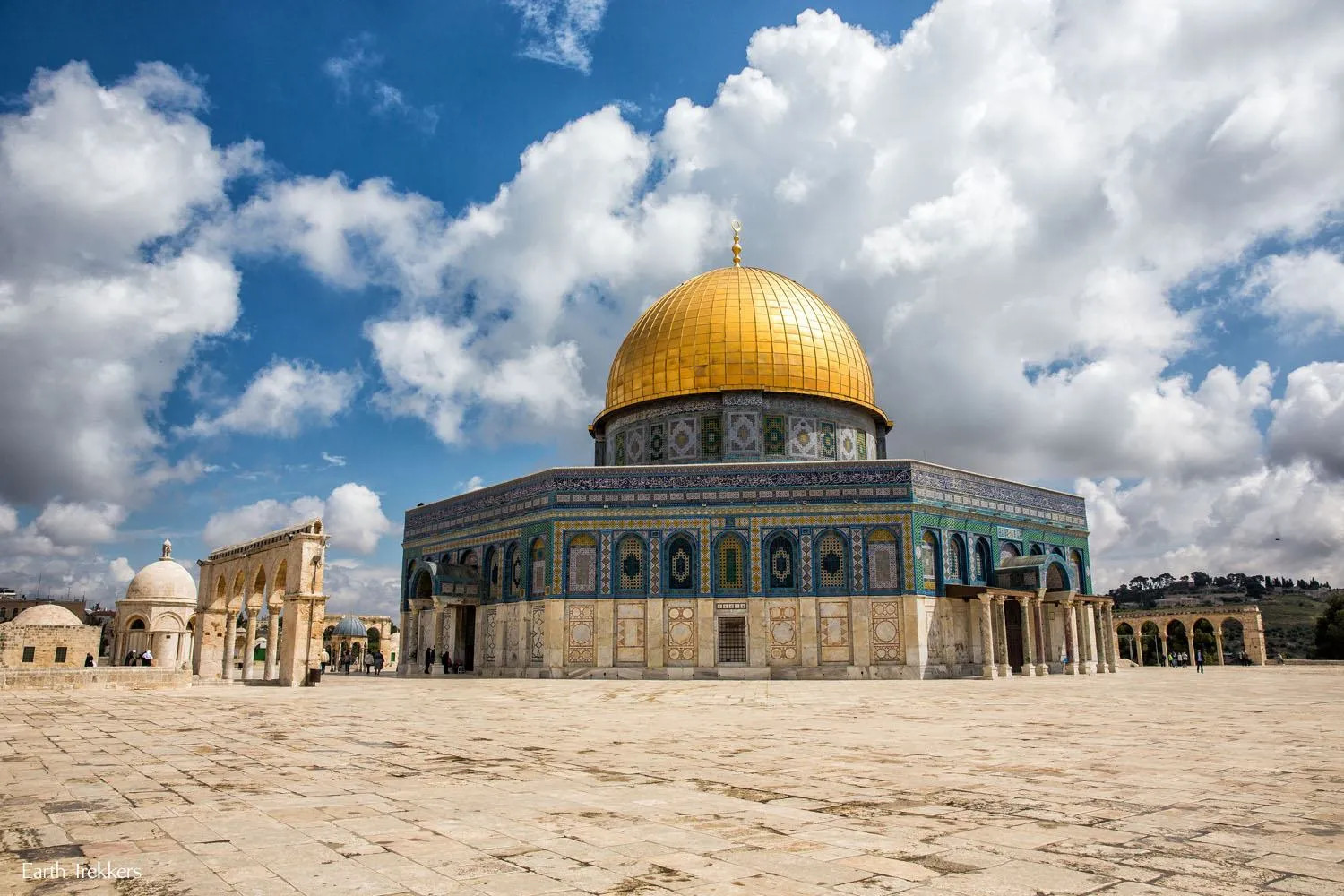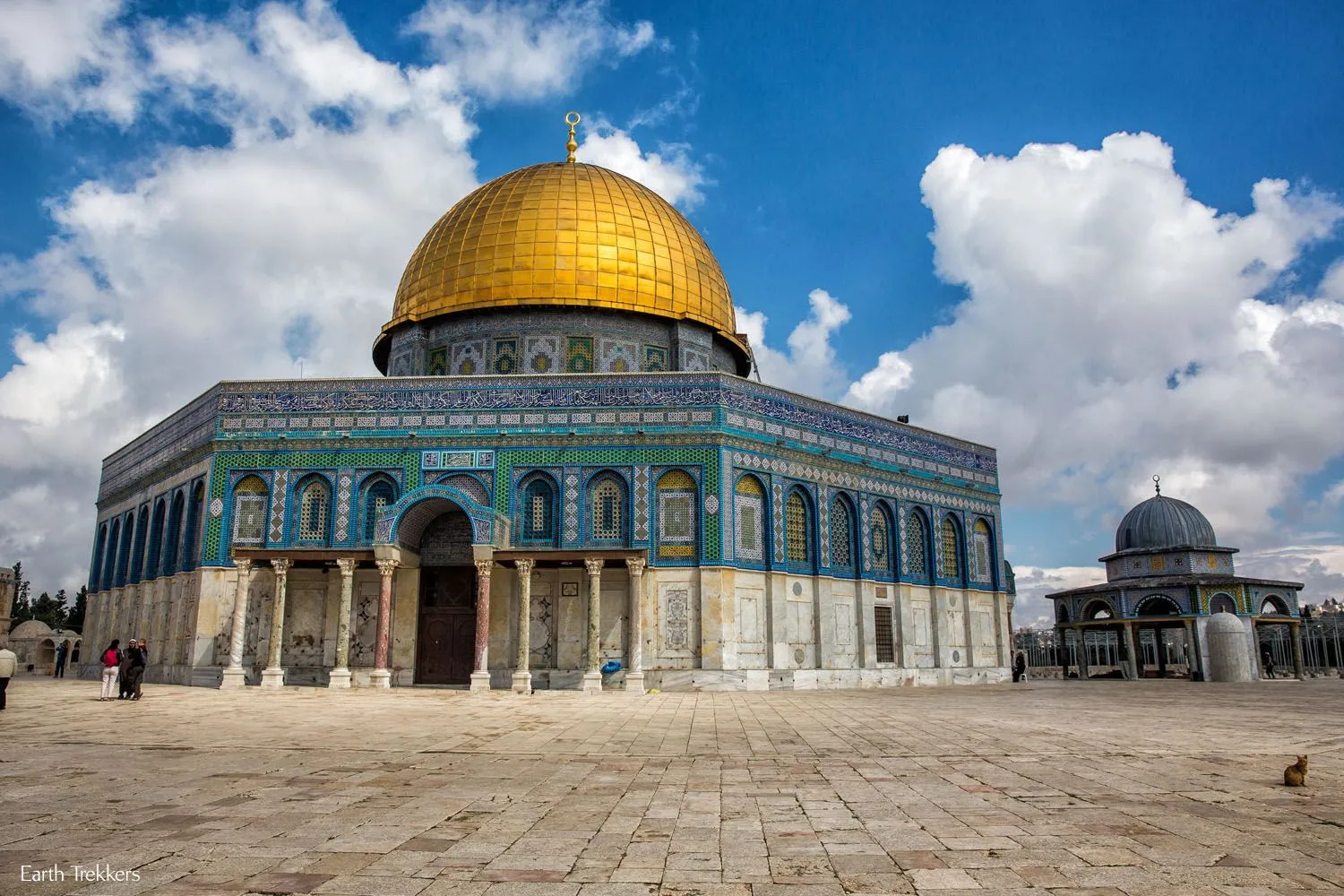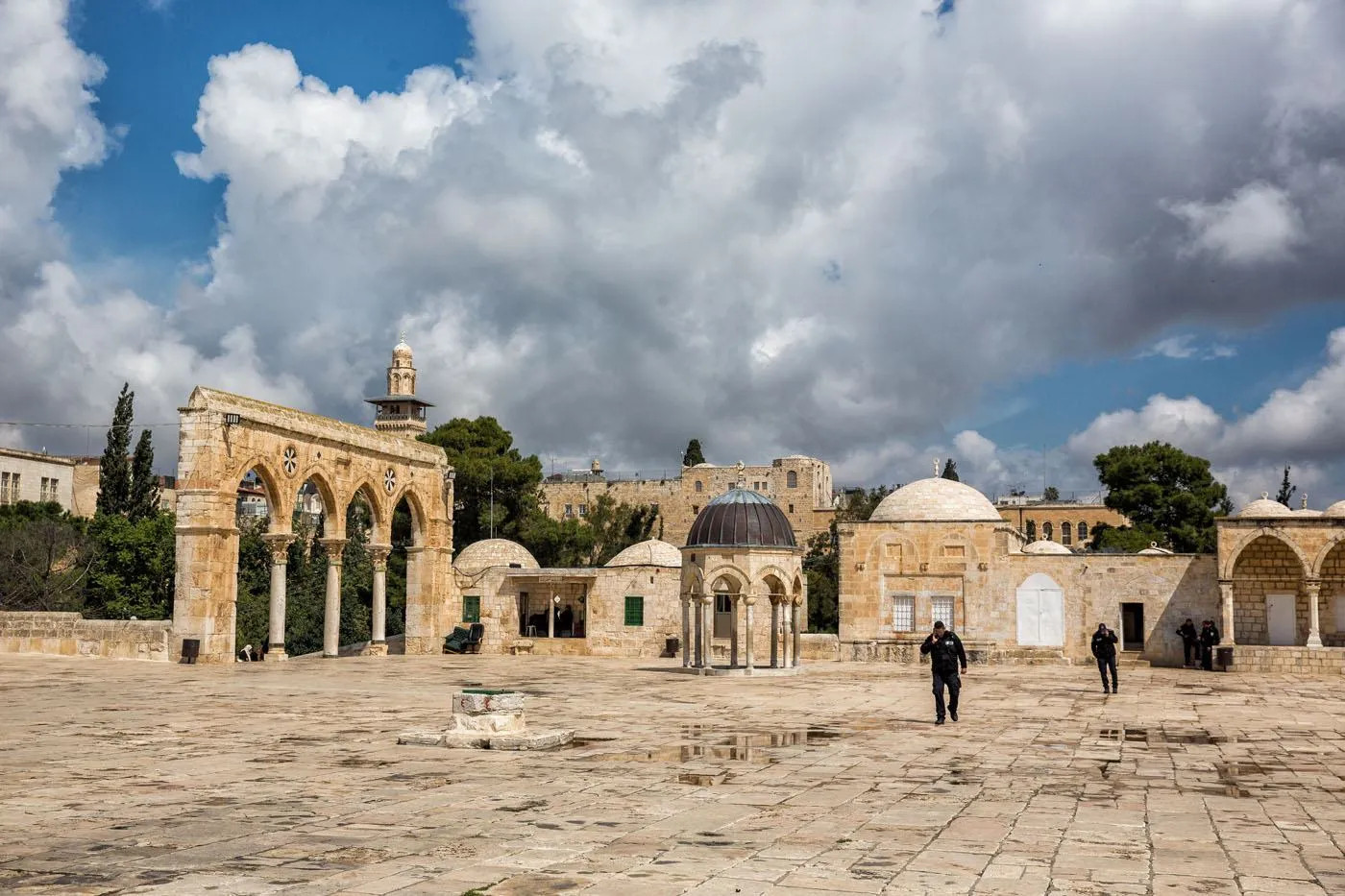Can You Visit The Dome Of The Rock? Absolutely! The Dome of the Rock, a stunning and historically significant landmark in Jerusalem, attracts countless visitors annually, and rockscapes.net is here to provide the essential guide for those planning a trip. Understanding the visiting hours, dress code, and regulations ensures a respectful and enriching experience at this iconic site, alongside exploring the beauty of the surrounding landscapes. Dive into our detailed guide below, and discover tips, insights, and practical information, ensuring a seamless visit to one of the world’s most revered locations. Let us explore rock formations and holy grounds.
1. Understanding The Significance Of The Dome Of The Rock
What is the Historical and Religious Significance of the Dome of the Rock?
The Dome of the Rock holds immense religious and historical importance for both Muslims and Jews. It is built on Temple Mount, a site revered in Judaism as the location of the First and Second Temples, and also as the place where Abraham was said to have prepared to sacrifice his son Isaac. For Muslims, the Dome of the Rock, also known as Qubbat As-Sakhrah, commemorates the spot from which the Prophet Muhammad ascended to heaven during his Night Journey.
The Foundation Stone within the Dome is sacred to both faiths, marking the spiritual heart of the structure. The architectural splendor and intricate designs reflect centuries of religious devotion and cultural heritage. The Dome of the Rock’s golden dome stands as a symbol of Jerusalem and its profound spiritual resonance, influencing architectural and artistic styles worldwide. Its historical value extends beyond religious contexts, embodying centuries of political and cultural interactions that have shaped the region.
What is Temple Mount?
Temple Mount, known as Haram al-Sharif to Muslims, is a large, elevated platform located in the Old City of Jerusalem. It holds unparalleled significance in both Judaism and Islam. For Jewish people, it is the holiest site, believed to be where the First and Second Temples once stood. It is also known as Mount Moriah, the location where Abraham was prepared to sacrifice his son Isaac. To avoid potentially stepping on the Holy of Holies, the most sacred area within the former Temples, many Jewish people do not walk on Temple Mount. Instead, they pray at the Western Wall, a retaining wall of Temple Mount.
For Muslims, Temple Mount is the third holiest site after Mecca and Medina. It houses the Al-Aqsa Mosque and the Dome of the Rock, which commemorates the spot where Prophet Muhammad ascended to heaven. This site was the original direction of prayer (qibla) for Muslims until the direction was changed to Mecca. The historical and religious importance of Temple Mount makes it a focal point of cultural and spiritual identity for millions worldwide.
2. Planning Your Visit To The Dome Of The Rock
What are the Visiting Hours for the Dome of the Rock?
Visiting hours for non-Muslims are typically Sunday through Thursday. However, these times can change, and it’s crucial to check the most recent updates before planning your visit.
- Summer (April – September): 7:30 AM to 11:00 AM and 1:30 PM to 2:30 PM
- Winter (October – March): 7:30 AM to 10:30 AM and 12:30 PM to 1:30 PM
The Dome of the Rock is closed to tourists on Fridays, Saturdays, and during Muslim holidays. Unexpected closures can occur, so it’s wise to confirm the hours on Google or with local sources before you go. Arriving at least an hour early is advisable, especially during peak tourist season, due to long queues and limited entry. Keep in mind that these hours can be adjusted due to security concerns or religious events.
How do I Enter Temple Mount?
Non-Muslims can enter Temple Mount through the wooden walkway near the Dung Gate, located outside the Western Wall area in the Old City of Jerusalem. Security checks are thorough; you’ll pass through metal detectors, and your belongings will be scanned. After security, ascend the wooden platform to the Bab al-Maghariba gate, which serves as the entrance.
Be prepared for a potentially lengthy wait, particularly during peak times. Security personnel are vigilant, ensuring that visitors adhere to the rules and regulations of the site. It is essential to have your passport or identification ready for inspection. Following these steps will help ensure a smooth and respectful entry to Temple Mount.
What is the Dress Code for Visiting the Dome of the Rock?
A strict dress code is enforced for visitors to Temple Mount. Modest attire is required:
- Men: Long pants and shirts covering the shoulders.
- Women: Long pants or skirts and shirts that cover shoulders and elbows. Clothes should be loose-fitting.
Sandals are allowed, but revealing clothing is not. A headscarf is not mandatory, though some women may choose to wear one as a sign of respect. Visitors who do not meet the dress code may be denied entry, so it’s crucial to dress appropriately to avoid disappointment. Dressing modestly shows respect for the religious significance of the site.
Are There Restrictions on What I Can Bring?
Yes, there are several restrictions on what you can bring into Temple Mount. Religious artifacts, including Christian and Jewish items, are prohibited. Security personnel may deny entrance if such items are found in your possession.
Cameras and phones are generally permitted, but using them for prayer or disruptive behavior is not allowed. Additionally, food and drinks are typically restricted. It’s advisable to bring only essential items to expedite the security process. Being aware of these restrictions helps ensure a smooth and respectful visit.
3. Navigating Temple Mount
What Can I Expect During My Visit to Temple Mount?
During your visit to Temple Mount, expect a serene and historically rich atmosphere. The site is vast and open, offering views of significant structures such as the Dome of the Rock and the Al-Aqsa Mosque. Non-Muslims are not allowed to enter these buildings, but you can admire their architecture from the outside.
The area is generally calm, with tourists and Muslim worshippers coexisting peacefully. Security personnel are present throughout the site, ensuring adherence to the rules. Be prepared for varying weather conditions, as the area offers little shade. The experience is both enlightening and awe-inspiring, providing a unique glimpse into one of the world’s most contested and sacred spaces.
Can Jewish People Enter Temple Mount?
Yes, Jewish people are permitted to enter Temple Mount, but certain restrictions apply. Prayer and the display of religious artifacts are not allowed. There is ongoing debate among Jewish religious authorities about whether Jewish people should visit Temple Mount, given its historical and religious significance.
Some Jewish people avoid entering the site to prevent inadvertently stepping on the “Holy of Holies,” the most sacred area of the former Temples. Despite these concerns, increasing numbers of Jewish people are visiting Temple Mount, often accompanied by guides who are knowledgeable about the site’s history and religious protocols. It’s important for all visitors to be respectful of the site’s religious sensitivities.
Are Non-Muslims Allowed Inside the Dome of the Rock?
No, non-Muslims are not allowed to enter the Dome of the Rock or the Al-Aqsa Mosque. These sites are reserved exclusively for Muslim worshippers. However, visitors can still appreciate the stunning exterior architecture and the surrounding grounds. Security personnel are vigilant in enforcing this rule, and attempting to enter these buildings may result in being asked to leave the Temple Mount. Admiring the Dome of the Rock from the outside provides a memorable experience, allowing you to take in the intricate details and historical grandeur.
What Security Measures are in Place?
Stringent security measures are in place at Temple Mount to ensure the safety and order of the site. Visitors undergo thorough security checks, including metal detectors and bag scanning, before entering. Security personnel, often armed, are stationed throughout the area to monitor activities and enforce regulations. These measures are designed to prevent any disturbances or violations of the site’s rules. It is crucial to cooperate with security personnel and follow their instructions at all times. The presence of security is a constant reminder of the sensitivity and significance of Temple Mount.
 View of Dome of the Rock from afar
View of Dome of the Rock from afar
Image showing the Dome of the Rock with its iconic golden dome, captured from a distance, highlighting its architectural splendor and dominance in the Jerusalem skyline.
4. Respectful Conduct on Temple Mount
How Should I Behave Respectfully?
To behave respectfully on Temple Mount, adhere to the dress code, avoid bringing religious artifacts, and refrain from prayer or religious displays if you are not Muslim. Maintain a quiet and respectful demeanor, and follow the instructions of security personnel.
Be mindful of worshippers and avoid disrupting their activities. Do not enter restricted areas, such as the Dome of the Rock and Al-Aqsa Mosque if you are not Muslim. Show consideration for the site’s religious significance by acting modestly and respectfully at all times. By observing these guidelines, you contribute to a harmonious and reverent atmosphere for everyone.
Are There Restrictions on Photography?
While photography is generally allowed on Temple Mount, there are some restrictions. Avoid photographing security personnel or sensitive areas. Be discreet and respectful when taking photos, and do not disrupt worshippers or block pathways. Using flash photography inside the Dome of the Rock or Al-Aqsa Mosque is prohibited. Always be mindful of your surroundings and respectful of the religious environment. Following these guidelines will help ensure you capture your memories respectfully and without causing offense.
What if I Witness Something Inappropriate?
If you witness something inappropriate on Temple Mount, such as disruptive behavior or violations of the rules, it is best to inform security personnel immediately. Do not engage directly with the individuals involved, as this could escalate the situation. Providing accurate information to the authorities will help them address the issue appropriately and maintain order on the site. Your vigilance and responsible reporting contribute to preserving the sanctity and safety of Temple Mount.
Can I Bring Food and Drinks?
Bringing food and drinks onto Temple Mount is generally restricted. It is advisable to avoid carrying these items to prevent delays or issues during security checks. Water is usually permitted, especially during hot weather, but it should be consumed discreetly and respectfully. Check with security personnel for any specific guidelines or exceptions on the day of your visit. Adhering to these restrictions helps maintain the cleanliness and reverence of the site.
5. Exploring the Surroundings of Temple Mount
What Other Attractions are Near Temple Mount?
Temple Mount is located in the heart of the Old City of Jerusalem, surrounded by numerous historical and religious attractions. The Western Wall, one of the most sacred sites in Judaism, is a short walk from the entrance to Temple Mount. The Church of the Holy Sepulchre, a central pilgrimage destination for Christians, is also nearby.
The Tower of David Museum offers insights into Jerusalem’s history, while the City of David archaeological site provides a glimpse into ancient Jerusalem. Exploring these sites in conjunction with your visit to Temple Mount enriches your understanding of the city’s diverse cultural and religious heritage.
Where Can I Find Accommodation?
Accommodation options near Temple Mount range from budget-friendly hostels to luxury hotels, catering to various preferences and budgets. The Jewish Quarter and Christian Quarter offer numerous hotels and guesthouses within walking distance of Temple Mount.
The Mamilla Hotel and The American Colony Hotel are renowned for their luxurious amenities and historical significance. For more affordable options, consider Abraham Hostel Jerusalem or the numerous guesthouses in the Old City. Booking in advance is advisable, especially during peak tourist seasons, to secure your preferred accommodation.
What are the Best Restaurants Nearby?
The Old City of Jerusalem and its surrounding areas boast a diverse culinary scene, with restaurants offering traditional Middle Eastern cuisine, international dishes, and local specialties. For an authentic experience, try Abu Shukri for hummus or Lina for traditional Palestinian dishes.
The Eucalyptus restaurant offers a modern take on biblical cuisine, while Rooftop at the Mamilla Hotel provides stunning views of the Old City along with gourmet meals. Whether you’re looking for a quick bite or a fine dining experience, you’ll find plenty of options to satisfy your palate near Temple Mount.
How Can I Get Around the Old City?
Navigating the Old City of Jerusalem is best done on foot, as the narrow, winding streets are mostly pedestrian-only. Comfortable walking shoes are essential. Taxis and private cars have limited access to certain areas. Public transportation, such as buses and the light rail, can take you to the outer edges of the Old City.
Consider hiring a local guide for a more in-depth exploration of the area. Be prepared for crowds, especially during religious holidays and peak tourist seasons. Exploring the Old City on foot allows you to fully immerse yourself in its rich history and vibrant atmosphere.
 Arial view of the Temple Mount
Arial view of the Temple Mount
Panoramic view of Temple Mount, capturing its vast expanse and key landmarks, including the Dome of the Rock and surrounding structures, showcasing the site’s layout.
6. Understanding the Controversy and Politics
What is the Current Political Situation?
The political situation surrounding Temple Mount is complex and sensitive. The site is a focal point of the Israeli-Palestinian conflict, with both sides claiming religious and historical rights. Israel controls access to the site, but the Jordanian Waqf manages the Islamic religious affairs. Tensions often arise due to restrictions on access, construction activities, and religious practices.
These tensions can escalate into protests and violence. Understanding the political context is crucial for visitors to be aware of potential disruptions and to approach the site with sensitivity. Staying informed about current events and respecting local customs are essential for a safe and respectful visit.
How Does This Affect My Visit?
The political sensitivities surrounding Temple Mount can affect your visit in several ways. Security measures are heightened, which may result in longer wait times and thorough checks. Unexpected closures can occur due to political unrest or religious events. It is essential to stay updated on the current situation and any travel advisories issued by your government.
Be prepared for the possibility of demonstrations or protests in the area. Respecting local customs and avoiding political discussions can help ensure a peaceful visit. Being aware of the political context allows you to navigate the site with greater understanding and caution.
What are the Different Perspectives?
There are diverse perspectives on the control and management of Temple Mount. Israelis view the site as their sovereign territory and emphasize their right to ensure security and access for all visitors. Palestinians see the site as an integral part of their national identity and seek greater control over its administration.
The Jordanian Waqf, which manages the Islamic religious affairs, aims to preserve the site’s Islamic character and prevent any changes to the status quo. International organizations and governments often call for maintaining the status quo and promoting peaceful coexistence. Understanding these different perspectives helps you appreciate the complexity of the situation and approach the site with empathy.
Where Can I Learn More?
To learn more about the history, politics, and religious significance of Temple Mount, consult reputable sources such as academic journals, historical texts, and news organizations with a track record of balanced reporting. Websites of organizations like the United Nations, UNESCO, and the Jerusalem Center for Public Affairs offer valuable information.
Engage with diverse perspectives by reading articles and books from various authors and viewpoints. Visiting museums and cultural centers in Jerusalem can also provide deeper insights. Staying informed from multiple sources helps you develop a comprehensive understanding of this complex and historically significant site.
7. Tips for a Smooth Visit
What Should I Wear?
To ensure a smooth and respectful visit to Temple Mount, dress modestly. Men should wear long pants and shirts that cover their shoulders. Women should wear long pants or skirts and shirts that cover their shoulders and elbows. Loose-fitting clothing is recommended.
Avoid wearing shorts, sleeveless shirts, or revealing attire. A headscarf is not mandatory but can be worn as a sign of respect. Comfortable shoes are essential, as you will be doing a lot of walking. Adhering to the dress code shows respect for the site’s religious significance and helps you avoid being denied entry.
What Time of Day is Best?
The best time of day to visit Temple Mount is early in the morning, shortly after it opens to non-Muslims. This allows you to avoid the long queues that can form later in the day, especially during peak tourist season. The morning light is also ideal for photography.
Alternatively, visiting during the early afternoon hours, after the morning rush, can also be a good option. Check the seasonal visiting hours and plan your arrival accordingly. Being strategic about the time of day can enhance your experience and minimize potential delays.
How Long Should I Plan to Stay?
Plan to spend at least two to three hours at Temple Mount to fully appreciate the site and its surroundings. This allows time for security checks, walking around the area, admiring the architecture, and taking photos. If you plan to visit nearby attractions, such as the Western Wall or the Tower of David Museum, allocate additional time accordingly.
The actual time spent on Temple Mount may vary depending on crowd levels and your personal interests. However, allowing ample time ensures a relaxed and comprehensive visit.
What Else Should I Know Before I Go?
Before visiting Temple Mount, there are several additional factors to consider. Check the official visiting hours and any recent updates or closures. Ensure you have your passport or identification ready for security checks. Be aware of the restrictions on bringing religious artifacts and food and drinks.
Familiarize yourself with the site’s rules and regulations, and be prepared to behave respectfully. Stay informed about the current political situation and any potential disruptions. By preparing in advance, you can ensure a smooth, respectful, and enriching visit to this historically significant site.
 A view of Temple Mount after rain
A view of Temple Mount after rain
This image shows Temple Mount shortly after a rainfall, with wet stone surfaces reflecting the surrounding architecture, creating a serene and reflective atmosphere.
8. Rockscapes.net and Landscape Design Inspiration
How Can Rockscapes.net Enhance My Appreciation of Natural Beauty?
Rockscapes.net is your premier online destination for inspiration and information related to incorporating natural stone into landscape design. Our website showcases a diverse collection of projects, from tranquil garden paths to striking rock formations, perfect for enhancing the beauty of any outdoor space. Whether you’re a homeowner, landscape architect, or gardening enthusiast, Rockscapes.net provides the ideas and resources you need to create stunning rockscapes.
Explore our galleries of completed projects and discover the potential of natural stone to transform your outdoor environment. Let Rockscapes.net be your guide to creating landscapes that harmoniously blend natural beauty with innovative design.
What Types of Stone are Ideal for Landscaping in the USA?
In the USA, the ideal types of stone for landscaping vary by region, depending on climate, soil conditions, and aesthetic preferences. Common choices include:
- Granite: Durable and versatile, suitable for pathways, walls, and water features.
- Limestone: Offers a classic, elegant look, ideal for garden borders and patios.
- Flagstone: Perfect for creating natural-looking walkways and patios.
- River Rock: Adds a touch of nature to gardens and water features.
- Slate: Known for its unique texture and color, suitable for pathways and decorative accents.
Rockscapes.net provides detailed information on these and other stone types, helping you select the perfect materials for your landscaping projects. Our expert advice ensures you choose stones that not only look beautiful but also withstand the test of time.
How Can I Incorporate Stone into My Garden Design?
Incorporating stone into your garden design can add texture, contrast, and a sense of permanence. Consider using stones as:
- Edging: Define garden beds and pathways with stone borders.
- Pathways: Create winding paths using flagstone or gravel.
- Rock Gardens: Showcase alpine plants and succulents in a natural rock setting.
- Water Features: Construct waterfalls or ponds using river rocks and boulders.
- Retaining Walls: Build sturdy and attractive walls to manage slopes.
Rockscapes.net offers tutorials and design ideas to guide you through every step of the process. Our resources help you transform your garden into a stunning oasis using the timeless beauty of natural stone.
What Resources Does Rockscapes.net Offer for DIY Landscaping Projects?
Rockscapes.net offers a wealth of resources for DIY landscaping enthusiasts. Our website features:
- Step-by-Step Guides: Detailed instructions for building pathways, rock gardens, and other landscape features.
- Design Ideas: Galleries of inspiring projects to spark your creativity.
- Material Selection Tips: Advice on choosing the right types of stone for your specific needs.
- Maintenance Advice: Tips for keeping your stone features looking their best.
- Supplier Directory: A list of trusted suppliers of natural stone and landscaping materials.
With Rockscapes.net, you have everything you need to tackle your DIY landscaping projects with confidence. Our comprehensive resources ensure your projects are both successful and visually stunning.
9. Frequently Asked Questions (FAQ)
Q1: Is it safe to visit the Dome of the Rock?
Visiting the Dome of the Rock is generally safe, but it’s essential to stay informed about the current political situation and any travel advisories. Security measures are in place to ensure visitor safety.
Q2: Can I pray inside the Dome of the Rock if I’m not Muslim?
No, non-Muslims are not allowed to pray inside the Dome of the Rock or the Al-Aqsa Mosque.
Q3: Are there guided tours available for Temple Mount?
Yes, guided tours are available, but it’s crucial to choose a reputable guide who respects the site’s religious sensitivities.
Q4: What happens if I don’t adhere to the dress code?
If you don’t adhere to the dress code, you may be denied entry to Temple Mount.
Q5: Can I bring a Bible or other religious text with me?
No, bringing religious artifacts, including Bibles or other religious texts, is not allowed.
Q6: Are there restrooms available on Temple Mount?
Yes, restrooms are available for visitors on Temple Mount.
Q7: Is there an entrance fee to visit Temple Mount?
No, there is no entrance fee to visit Temple Mount.
Q8: What languages are spoken by the security personnel?
Security personnel typically speak Arabic and Hebrew, but some may also speak English.
Q9: How can I stay updated on any closures or changes to visiting hours?
Check the official websites or local news sources for the most up-to-date information.
Q10: Can I visit Temple Mount on a Friday or Saturday?
No, Temple Mount is closed to tourists on Fridays and Saturdays.
10. Conclusion: Experience the Beauty and History
Visiting the Dome of the Rock is a unique opportunity to experience a site of immense religious and historical significance. By planning your visit carefully, respecting the local customs, and staying informed about the current situation, you can ensure a smooth and enriching experience.
And while you’re exploring the beauty of the Middle East, don’t forget to bring that inspiration home. Visit rockscapes.net for ideas on how to incorporate the timeless beauty of natural stone into your own landscape. Discover design ideas, practical tips, and reliable resources to transform your outdoor space into a stunning oasis. Let rockscapes.net be your guide to creating landscapes that reflect the beauty and serenity of the world’s most captivating locations.
Are you ready to transform your landscape with the timeless beauty of natural stone? Contact us today at Address: 1151 S Forest Ave, Tempe, AZ 85281, United States or call us at Phone: +1 (480) 965-9011. You can also explore our extensive collection of design ideas and resources on our website: rockscapes.net. Let Rockscapes be your trusted partner in creating the landscape of your dreams!
